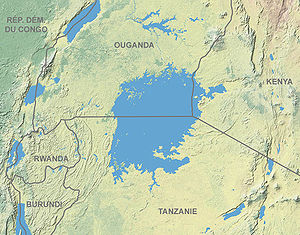Mount Elgon National Park
|
Mount Elgon National Park
|
|
| location |
|
| surface | 1279 km² (both parts) |
| WDPA ID | 28175 |
| Geographical location | 1 ° 8 ' N , 34 ° 35' E |
| Sea level | from 2336 m to 4321 m |
| Setup date | Kenya: 1968, Uganda: 1992 |
| administration | Kenya Wildlife Service , Uganda Wildlife Authority |
The Mount Elgon National Park is a national park 140 km northeast of Lake Victoria near the town of Mbale on the border between Uganda and Kenya . The park covers a total area of 1279 km², of which 1110 km² are in Uganda and 169 km² in Kenya. It is located at an altitude of 2336 to 4321 m above sea level. The highest point and namesake is the extinct volcano Mount Elgon . Some of the peaks are in Kenya; It is also known from there that elephants and other animals come from far away to eat salty earth in the lava caves .
A mosaic of grasslands, swamps, moors and mountain rainforest shapes the character of this landscape. The annual precipitation is over 1200 mm.
The Mount Elgon National Park is home to leopards , eland , buffalo , bushbuck and giant forest pigs . There is also a small population of elephants. This was given in 1973 with 500 and 1977 with 1000 specimens, but in 1987 there were only 200 animals. The elephants are quite shy. Their traces can be found in the large rock caves of the mountain range, where they absorb minerals every few days.
criticism
When it was founded, around 30,000 Sabiny (an ethnic group from this region) were forcibly resettled in the so-called Benet resettlement area. The first shipment from the national park area to this resettlement area took place in 1983 and was only "partially successful" - a considerable part of the Sabiny evaded resettlement and remained in the national park. The government only made bare land available to the resettled. They were not offered start-up aids such as building materials, agricultural implements, seeds or the like. A second wave of resettlement occurred in 1992 when people were forced to leave the national park at gunpoint. In the course of this punitive action, people were beaten, there were numerous physical injuries and rape, the Sabiny cattle were slaughtered and their houses were set on fire. But that's not all: In the course of this eviction, the size of the resettlement area made available in 1983 was checked by the Uganda Wildlife Authority (UWA) and reduced from 7,500 to 6,000 hectares. That means that overnight around 6,000 people who had spent over ten years cultivating the land they were assigned lost their livelihood again. Again they became "intruders" and unwanted settlers. Further shifts in the boundaries of the resettlement area to the detriment of the Sabiny took place in 2002 and 2004. At the same time, the UWA rangers turned to stricter enforcement of national park laws after the end of the political unrest in Uganda. People who lived outside the newly drawn borders of the resettlement area were exposed to constant threats, harassment and physical attacks by the UWA rangers, including rape of women collecting wood. The indigenous people of this region do not benefit from the relative political calm that has prevailed in Uganda for several years. The EU, the World Bank and the German Society for Technical Cooperation GmbH (GTZ) are accused of sharing responsibility for the displacement of over 130,000 people in Uganda through their training seminars for employees of the Ugandan forest and wildlife authorities.
literature
- Wally Hagen, Horst Hagen: The African national parks as habitats for elephants. In: Vitus B. Dröscher (Ed.): Save the elephants of Africa. Quickly u. Röhring, Hamburg 1990, ISBN 3-89136-291-9 , pp. 99-131, here p. 228.
Web links
- Uganda Wildlife Authority: Mount Elgon National Park (English)
- Kenya Wildlife Service: Mount Elgon National Park ( Memento from June 27, 2015 in the Internet Archive ) (English)
- Project Elgon. Ecological research project, carried out in 1996 and 1997
- Chris Lang and Timothy Byakola: "A funny place to store carbon": UWA-Face Foundation's tree planting project in Mount Elgon National Park Uganda. World Rainforest Movement, December 2006
Individual evidence
- ↑ Uganda: World Database on Protected Areas - Mount Elgon National Park (English)
- ↑ Kenya: World Database on Protected Areas - Mount Elgon National Park (English)
- ↑ Chris Lang, Timothy Byakola: "A funny place to store carbon" , December 2006.

